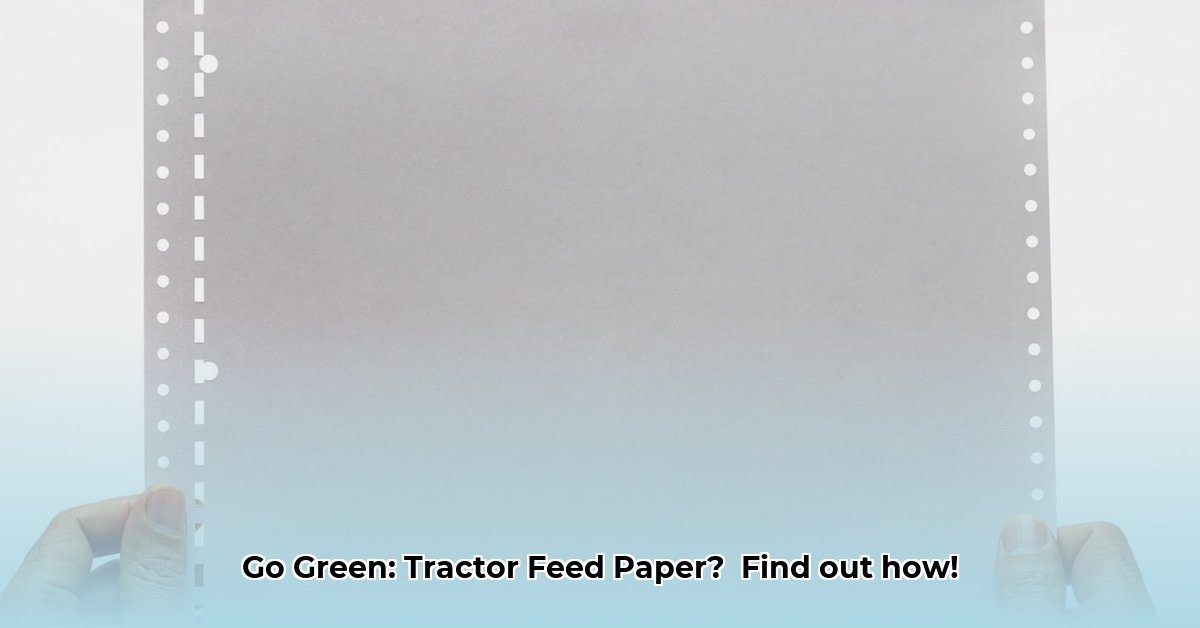
Paper Tractor Feed: Minimizing Environmental Impact on the Farm
Tractor-feed paper: a farming staple, yet a significant environmental concern. From tracking yields to managing finances, its convenience is undeniable. However, its lifecycle—from tree harvesting to landfill disposal—leaves a substantial carbon footprint. This guide explores the environmental impact of tractor-feed paper and provides actionable steps for a greener farming future. We'll examine the challenges and explore effective solutions, empowering you to minimize your farm's environmental footprint. For alternative fuel sources, check out this resource on alfalfa pellets.
The Environmental Impact: A Comprehensive Look
The environmental cost of tractor-feed paper is multifaceted. Firstly, tree harvesting, if not sustainably managed, contributes to deforestation, habitat loss, and reduced carbon sequestration. The manufacturing process itself is energy-intensive, consuming vast quantities of water and releasing greenhouse gases. Transportation then adds to the overall carbon emissions. Finally, the disposal often ends in landfills, contributing to waste accumulation and potential soil and water contamination. This complete lifecycle presents a significant environmental challenge. Did you know that the average farm uses [Insert Data from Draft Article on Annual Paper Consumption] pounds of tractor-feed paper annually? That's a lot of paper!
Evaluating Your Paper Usage: A Critical Assessment
Before implementing changes, assess your current paper usage. Begin by tracking your annual consumption. What documents are routinely printed? Are there variations in paper type across different farming operations? This inventory, even a simple spreadsheet, identifies areas for improvement and informs a targeted approach to sustainable practices. Remember, data-driven decision-making is crucial for effective change.
Practical Steps: A Sustainable Transition
Transitioning to sustainable practices doesn't require a radical overhaul. Start small, building momentum with these manageable steps:
Embrace Digital Record-Keeping: Transition to digital farm management software. This significantly reduces paper consumption, offering increased efficiency and data organization. Investing in appropriate software and hardware will deliver long-term cost and environmental savings – often yielding a return on investment within [Insert Data from Draft Article on ROI of Digital Transition] months.
Optimize Printing Practices: If printing remains necessary, double-sided printing is a simple yet impactful step. Standardize document templates to minimize wasted space. Choose energy-efficient printers. Always ask – "Is printing truly necessary?" Email or digital files often suffice.
Source Sustainable Paper: When purchasing paper, prioritize recycled options. Look for certifications like the Forest Stewardship Council (FSC) 1 certification, ensuring responsible forestry and reduced environmental impact. This certification guarantees sustainable sourcing, minimizing deforestation and habitat destruction.
Responsible Disposal: Ensure proper paper recycling. Check your local guidelines for accepted materials and procedures. Many communities have dedicated programs. Proper disposal prevents paper from ending up in landfills, reducing waste and environmental damage.
Explore Alternatives: Consider whiteboards or digital tablets for specific tasks. These reusable alternatives significantly reduce dependence on single-use paper, lowering overall consumption.
Digital vs. Paper: A Comparative Analysis
Let's weigh the environmental and economic aspects:
| Feature | Digital Record-Keeping | Traditional Paper |
|---|---|---|
| Environmental Impact | Significantly lower carbon footprint | Higher carbon footprint due to resource use and waste |
| Upfront Costs | Higher initial investment in technology and training | Lower initial investment |
| Ongoing Costs | Lower long-term costs (less paper, ink, etc.) | Higher ongoing costs (purchasing, storing, disposing of paper) |
| Accessibility | Requires technology and training | Relatively easy to access and use |
| Data Security | Potential digital security risks; Requires robust measures | Lower risk of data breaches; Physically secure |
| Data Backup & Recovery | Easy data backup and recovery | More difficult; prone to damage |
Building a Sustainable Agriculture Future: A Collaborative Effort
Adopting sustainable practices is a continuous process. What does a truly sustainable approach look like? It requires collective action. Farmers, suppliers, and policymakers must work together towards more sustainable paper solutions and a circular paper economy. While completely eliminating paper may not be immediately feasible for every farm, every step taken contributes to creating a healthier planet.
The Bottom Line: Cumulative Impact of Sustainable Choices
Reducing reliance on tractor-feed paper is a crucial step towards sustainable agriculture. By integrating these strategies, you'll minimize your farm's environmental impact. Remember, consistent improvements, however small, contribute significantly to a healthier planet. Every sustainable choice you make has a positive ripple effect, contributing to a more responsible and efficient farming system.